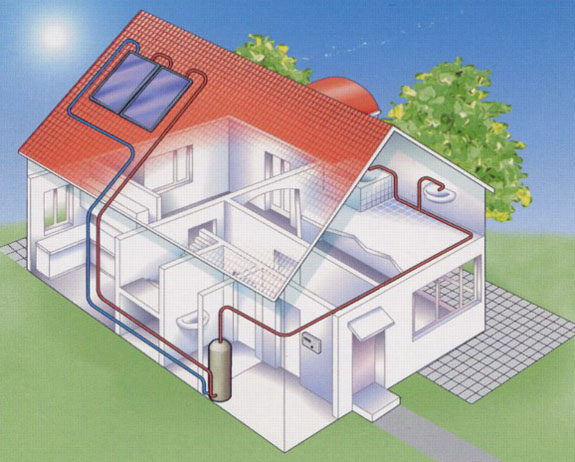 A Solar Hot Water (or “Solar Thermal”) system can provide as much as 70-80% of your hot water needs for the year, greatly reducing the portion of your utility bill that relates to water heating, usually natural gas. If the water heater is electric, the money saved is even greater. A full-size system will typically provide all the hot water needed between March and October.
A Solar Hot Water (or “Solar Thermal”) system can provide as much as 70-80% of your hot water needs for the year, greatly reducing the portion of your utility bill that relates to water heating, usually natural gas. If the water heater is electric, the money saved is even greater. A full-size system will typically provide all the hot water needed between March and October.
Although the basic technology has been around for a number of years, recent improvements make today’s solar hot water systems more efficient, reliable, and durable than those of the past.
A typical domestic solar hot water system uses two 4′ x 8′ flat plate “collectors” which are installed on the rooftop of a home or business (but can be located on the ground). These flow to a hot water heater, which is used as a storage tank and for back-up heat during the cold months of the year.
General Types of Systems
Hot Water systems are of two general types.
The first is one in which potable water is passed through tubes and heated by the sun before flowing into the storage and heating unit.
The second type is one in which non-toxic glycol circulates through the tubes, heated by the sun and flows to a heat exchanger where it heats the water. A back-up heater provides any additional heating of the water.
Spa systems and pool systems function in a similar manner.
System Sizing
Domestic Hot Water
Generally, domestic hot water systems are sized according to the number of people in your family. Typically, two 4 ft. x 8 ft. collectors and a 120 gallon storage tank is sufficient for two adults.
Swimming Pool
Pool Systems require that solar collectors have a combined surface area equal to 50 – 70% of the pool surface area, with “glazed” type collectors being the most efficient.
